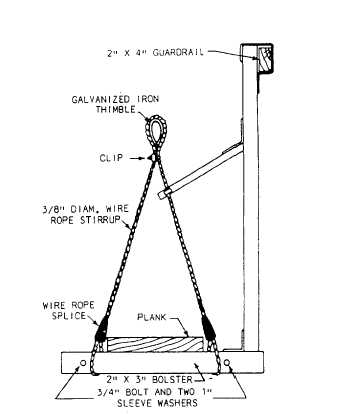apart. The spread between legs must be no more than two-thirds nor less than one-half the length of a leg, Small tripods, or those lashed according to the first procedure given in the preceding section, may be raised by hand. Here are the main steps.
Start by raising the top ends of the three legs about 4 feet, keeping the butt ends of the legs on the ground. Now, cross the tops of the two outer legs, and position the top of the third or center leg so that it rests on top of the cross.
A sling for the hoisting tackle can be attached readily by first passing the sling over the center leg, and then around the two outer legs at the cross. Place the hook of the upper block of a tackle on the sling, and secure the hook by mousing.
The raising operation can now be completed. To raise an ordinary tripod, a crew of about eight maybe required. As the tripod is being lifted, spread the legs so that when it is in the upright position, the legs will be spread the proper distance apart. After getting the tripod in its final position, lash the legs near the bottom with line or chain to keep them from shifting (figure 4-40). Where desirable, a leading block for the hauling part of the tackle can be lashed to one of the tripod legs, as indicated in figure 4-40.
In erecting a large tripod you may need a small gin pole to aid in raising the tripod into position. To erect a tripod lashed according to the first procedure described in the preceding section, you first raise the tops of the legs far enough from the ground to permit spreading them apart. Use guys or tag lines to help hold the legs steady while they are being raised. Now, with the legs clear of the ground, cross the two outer legs and place the center leg so that it rests on top of the cross. Then, attach the sling for the hoisting tackle. Here, as with a small tripod, simply pass the sling over the center leg and then around the two outer legs at the cross.
SCAFFOLDING
LEARNING OBJECTIVE: Upon completing this section, you should be able to determine the proper usage of wood and prefabricated metal scaffolding.
As the working level of a structure rises above the reach of crew members on the ground or deck, temporary elevated platforms, called scaffolding, are erected to support the crew members, their tools, and materials,
There are two types of scaffolding in use today-wood and prefabricated. The wood types include the swinging scaffold, which is suspended from above, and the pole scaffold, which is supported on the ground or deck. The prefabricated type is made of metal and is put together in sections, as needed.
SWINGING SCAFFOLD CONSTRUCTION
The simplest type of a swinging scaffold consists of an unspliced plank that is made from 2-by-8-inch (minimum) lumber. Hangers should be placed between 6 and 18 inches from the ends of the plank. The span between hangers should not exceed 10 feet. Make sure that the hangers are secured to the plank to stop them from slipping off. Figure 4-42 shows the construction of a hanger with a guardrail. The guardrail should be made of 2-by-4-inch material between 36- and 42-inches high. A midrail, if required, should be constructed of 1-by-4 lumber.

Figure 4-42. - Typical hanger to use with plank scaffold.
Continue Reading